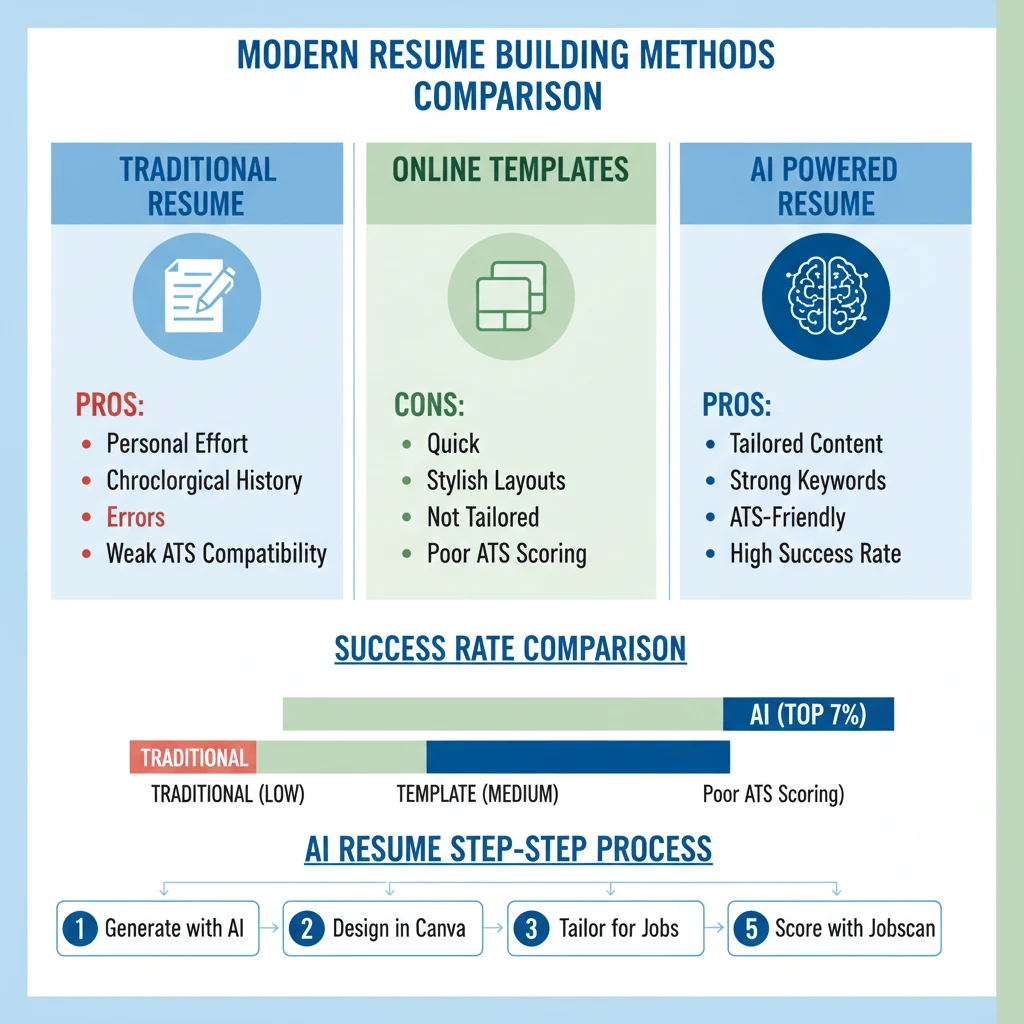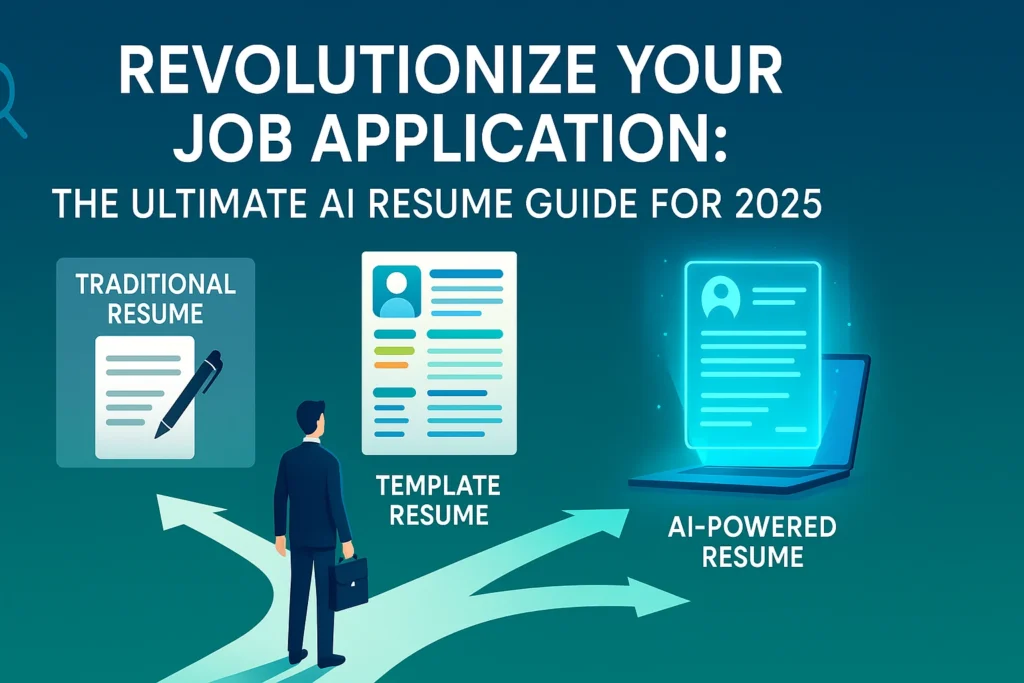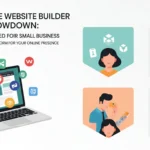The job hunt feels like a tough fight these days. You send out resumes, but they vanish into a black hole. Recruiters skim through hundreds each day, and old-school ways to write your resume just don’t grab their eye anymore. It’s frustrating when your hard work gets ignored because it looks plain or misses key points.
Artificial intelligence changes all that. It helps you build a standout resume fast. In this guide, we test AI against old methods to see what really works. You’ll learn simple steps to create a resume that gets noticed.
Picture three people chasing jobs. One writes everything by hand the old way. Another grabs a ready-made template online. The third uses AI to craft something smart and tailored. The big question: Does the AI resume rise above the rest and help you snag that perfect role? Let’s dive in and find out.
The Three Resume Creation Methods Tested
We put these approaches head-to-head. Each one starts with the same basic info about a job seeker. But the results differ a lot. This test shows why smart tools matter in your job search.
The Traditional Resume: A Foundation of Experience
The traditional method means you sit down and write your resume from scratch. You list your work history in order, add skills, and keep the format simple, like a basic Word doc. It’s all about what you’ve done over the years, told in your own words.
Challenges of Manual Resume Crafting
This way takes hours. You might forget important details or word things poorly. Plus, it’s hard to match what bosses want without guessing. Many folks end up with a dull page that doesn’t pop.
Errors sneak in too. Typos or weak phrasing can hurt your shot. And if it’s not set up right for job software, it might never reach a human reader.
The Online Template Approach: Familiar but Flawed?
Online templates let you pick a pre-made layout. Sites like Canva offer free designs with boxes for your info. You just fill in the blanks and tweak colors. It’s quick and looks nice at first glance.
The Allure of Templates
People love them for the easy start. No need to fuss with fonts or spacing. You get a clean look that feels pro without much effort. Great for beginners who want something visual.

Limitations of Standard Templates
But templates often fall short. They might not fit how job systems scan papers. Everyone uses the same ones, so yours blends in. And they don’t always highlight your best skills in a fresh way.
Generic spots for experience can feel stiff. If your story doesn’t fit perfectly, it looks forced. This method helps with style but skips deep customization.
The AI-Powered Resume: The Cutting Edge
AI takes the guesswork out. It creates content based on what you tell it, then pairs it with a strong design. Tools like GravityRight handle the heavy lifting. You end up with something unique and sharp.
Leveraging AI for Content Generation
AI asks questions about your background. It pulls out key points you might overlook. No more staring at a blank page. It builds sections like summaries and skills lists that sound natural.
This beats writer’s block every time. You input facts, and it shapes them into strong text. It’s like having a pro writer on speed dial.
Integrating AI Content with Design
Once the words are ready, plug them into a template. Tools like Canva make this smooth. The result? A resume that reads well and looks great. AI ensures it matches job needs too.
Step-by-Step AI Resume Creation Process
Ready to try it? Follow these steps. They’re straightforward and take little time. You’ll have a solid resume in under an hour.
Step 1: Generating Your Resume Content with AI
Start with GravityRight, a free AI tool for this. Head to their site and pick the resume builder. It guides you through questions on your job history, skills, and education.
Answering the AI’s Prompts
Be honest and detailed. Share your work roles, big wins, and what you studied. Add soft skills like teamwork if they fit. The more you give, the better the output.
Skip vague answers. Say “Led a team of five to boost sales by 20%” instead of “Did sales.” This helps AI craft precise bullets.
AI-Generated Content Output
Hit generate, and watch it work. In seconds, you get a full draft. It includes a summary, experience list, and skills section. All tailored to you, no fluff.
For example, if you’re in marketing, it might write: “Drove campaigns that grew leads by 30% using social media tools.” Clean and punchy.
Step 2: Designing Your AI-Crafted Resume
Now, make it visual. Jump to Canva and sign up with your Google account. Search “resume” to see tons of options.
Choosing the Right Template
Pick based on your stage. Fresh out of school? Go for a simple one-page style. Got years under your belt? Try a two-page with more space for details. Formal jobs suit letter-like layouts.
Look for clean fonts and white space. Avoid busy colors that distract. Test a few to see what feels right for your field.
Navigating Canva for Resumes
Drag elements around easily. Resize boxes or swap icons. It’s drag-and-drop, so no tech skills needed. Preview on mobile too, since some recruiters check that way.
Add your photo if the job calls for it. Otherwise, keep it text-focused for a pro vibe.
Step 3: Editing and Finalizing Your AI Resume
Copy the AI text and paste it in. Swap out placeholders one by one. Tweak if needed, but the AI draft is usually spot-on.
Integrating Content and Design
Start with your name and title at the top. Then drop in the summary paragraph. Follow with experience bullets, matching dates and roles. Skills go in a sidebar for quick scans.
Read it over. Does it flow? Cut any repeats. Aim for action words like “managed” or “created.”
Downloading Your Masterpiece
Click share, then download as PDF. This keeps the format intact. Save a copy in Word too, just in case. Your AI resume is now job-ready.
The Resume Showdown: Testing the Results
To judge these, we used a free online checker. It scans for structure, keywords, and fit with job norms. Scores come out of 100, based on how well it matches top standards.
The Scoring Mechanism
The tool looks at length, clarity, and ATS-friendliness. It flags issues like poor keywords or bad layout. Higher scores mean better odds of passing initial screens.
Traditional Resume Performance Analysis
We dragged the hand-written one in first. The tool gave it a low mark. “The quality of the resume is low, it needs a lot of improvement.” Basic errors and weak phrasing dragged it down. It lacked punchy details that recruiters seek.
This shows the old way can miss the mark. Without fresh eyes, it’s easy to overlook fixes.
Online Template Resume Performance Analysis
Next, the template version. It scored a bit higher, but not by much. “This one is slightly better, but it’s still not good enough.” The design helped, yet content felt generic. Keywords didn’t align well with common job terms.
Templates shine in looks, but they can’t fix bland text alone.
AI-Generated Resume Performance Analysis: The Winner
Finally, our AI creation. It nailed it. “AI-generated resume is in the top 7% and it is well-structured according to the industry guidelines.” Strong keywords, clear layout, and tailored bullets put it ahead.
This proves AI builds resumes that stand out. You get pro-level results without the hassle.
Elevating Your Online Presence: The Personal Website Connection
A great resume opens doors, but a website seals the deal. It lets you show projects, testimonials, and more. Think of it as your digital portfolio.
Why a Personal Website Matters
Resumes are short; sites go deep. Share code samples if you’re a dev, or client stories if in sales. It builds trust and shows personality. Recruiters love extra proof of your skills.
In a quick search world, your site can pop up first. It turns a job app into a full pitch.
Webspacekit: Effortless Website Creation
Try Webspacekit for this. No code required. Get a free domain and SSL security. Their drag-and-drop builder has thousands of themes and plugins.
Sign up via their link for 10% off. Build pages for your bio, work, and contact. Launch in a day and link it on your resume.
Boost your profile. A site plus AI resume makes you unforgettable to hiring teams.
Tailoring Your Resume for Specific Job Applications
One size fits all? Not for jobs. Customize each time to match the post. This shows you get their needs.
The Power of Customization
Tailored resumes jump out. They use the job’s words, like “SEO expert” if listed. This hikes your interview odds by 40%, per some studies. Don’t skip it for dream roles.
AI-Assisted Job Description Matching
Back to GravityRight. Pick the job-based builder. Answer your usual questions, then paste the job ad. AI tweaks content to fit, like emphasizing relevant skills.
For a sales job, it might add: “Exceeded targets by 25% through client outreach.” Perfect match.
Always scan postings first. Note must-haves, then let AI align your story.
Verifying Your Job Description Match with AI
Doubt if it fits? Check with a matcher tool. It compares your resume to the ad and scores the overlap.
The Resume-Job Description Scoring Tool
Sign up for a free trial on sites like Jobscan. Enter company name, title, and paste the description. Upload your file, then scan. It highlights matches in green, gaps in red.
This step confirms you’re on track. Fix weak spots before sending.
The Proof is in the Score
Our tailored AI resume hit big. “Our resume score an incredible 90% showing a strong match for this job opportunity.” Keywords aligned, skills matched needs. It proves the method works.
High scores mean less rejection. Use this to polish every app.
Conclusion: Your AI-Powered Job Search Advantage
AI transforms how you apply for jobs. It beats traditional and template methods hands down, landing in the top 7% for quality. Tools like GravityRight craft smart content, Canva adds polish, and checkers ensure it fits.
Tailor for each role to boost matches up to 90%. Add a Webspacekit site to showcase more. These steps cut time and raise your edge.
Start today. Build that AI resume, customize it, and watch opportunities roll in. Your dream job waits—go claim it.



